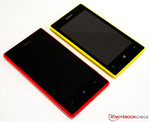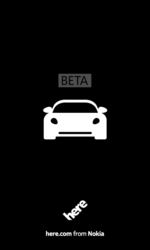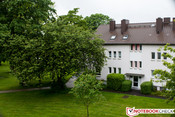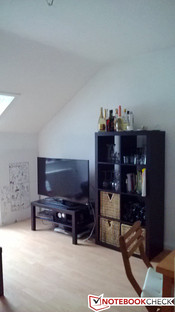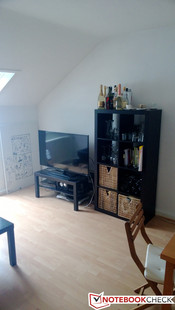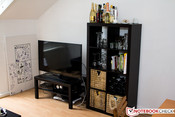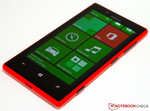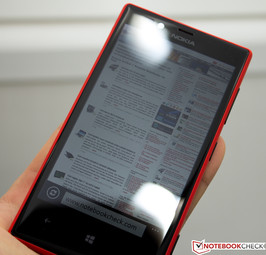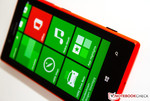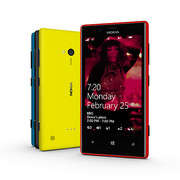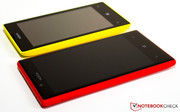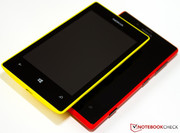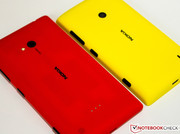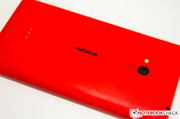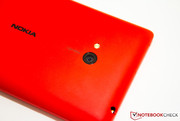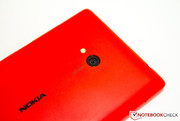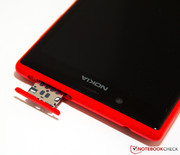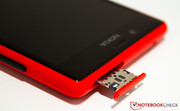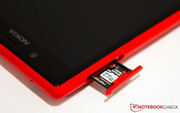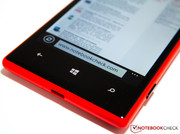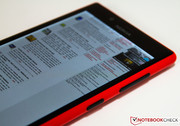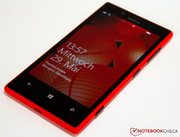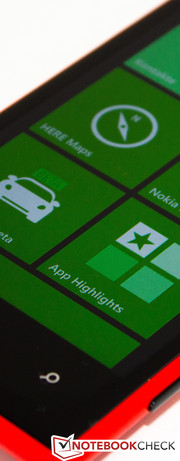Review Nokia Lumia 720 Smartphone
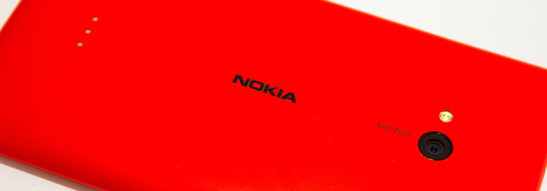
For the original German review, see here.
The Finnish company has been very busy launching new Lumia devices for a few months now. The Lumia 720 is a relatively new addition to Nokia’s portfolio and has been available since March. If you have a look at the specifications of different Lumia devices you will notice that the differences are very small. We just reviewed the Lumia 520 which was very similar to the Lumia 620 at a lower price point. Now we have the Lumia 720 which demands a premium over the price of the Lumia 620. The main difference of the bat is the larger 4.3-inch display which makes it a significantly larger phone. The retail price of 379 Euros (~$500) for the small list of additional features included in the device is aimed at a more moneyed segment.
Case
Similar to the other Lumias we reviewed (Lumia 520 and 620) the build quality is very good. Unlike the cheaper Lumias, there is no access to the battery of the phone. The matte finish on the back does not attract fingerprints and is very resistant to pressure. Our review unit is slightly wider with dimensions of 127.9 x 67.5 x 9 mm which makes it much thinner than the Lumia 520 and the 620.
Connectivity
We really like the fact that the internal storage can be expanded via micro SD card. The slot is on the left side since the back cover cannot be removed. The layout of the other touch and hardware buttons is similar to the Lumia 520.
Communication & GPS
There is a small but important upgrade in regard to the WLAN module. It now uses dual band technology and can send and receive data in the 2.4 and 5 GHz networks. You also get an NFC module (Near Field Communication) and Bluetooth 3.0. We could not determine any problems or sudden connection losses with the UMTS module or the other wireless connections.
The integrated A-GPS receiver works very well indoors with decent accuracy. Combined with HERE Maps or HERE Drive from Nokia, the module delivers good results.
Software
Nokia exclusively uses the Windows operating system and has the same Windows Phone Build as on the other Lumias. Due to the restrictions on the extent of customization by Microsoft, there are no special modifications done to the OS, hence this section being as small as it is.
Cameras & Multimedia
Nokia provides two cameras on this device. The main shooter has a resolution of 6.7 MP. It has a Carl Zeiss lens; an aperture of f/1.9 and a focal length of 26 mm. Macro shots can be taken from a distance of 10 cm. The integrated LED flash has a range of 1 meter. The camera above the touchscreen only has a resolution of 1.2 MP (aperture: f/2.4).
One of the best ways to assess the performance of a camera is to take low-light shots. Bad lighting conditions can be easily simulated indoors. The images had problems with noise to a small extent with poor illumination in some sections. The quality couldn’t be improved even with the integrated LED flash. We expected a higher level of detail from the 6.7 MP sensor. The results of the front camera are similarly dark and obviously more blurry due to the lower resolution. Outdoors (cloudy day), the results are considerably sharper. However, the colors are a bit pale and the white of the wall is slightly reddish. The front camera has the same problem with pale colors and the pictures are blurry.
Accessories & Warranty
Unfortunately, there is not much we could list here. The small box does not have the space for any interesting accessories. Besides the modular power supply unit and an On-Ear-Headset, there is just a printed Quick Start Guide.
Like all the other Nokia devices, the Lumia 720 has a 24-month warranty for the device itself. The warranty period for the battery is limited to twelve months and six months for the PSU.
Input Devices & Handling
We already expected it – haptic feedback and handling of the touchscreen are no different from the other Lumia devices. Inputs are executed very precisely and quickly with the operating system being similarly responsive to touch.
The virtual QWERTY keyboard occupies 50 % of the display in portrait mode. It needs even more space in the landscape mode. The layout of the keyboard is convenient however you can hardly see any content on screen while typing.
Display
The main differentiator is the display. It is 4.3 inches across and has a resolution of 800 x 400 pixels (WVGA). A jump to HD-resolution would have been appropriate as the inexpensive Lumia 520 comes with the same WVGA resolution. The capacitive IPS display can present 16.7 million colors (24 bit) and is protected by Corning Gorilla Glass 2. The Lumia 720 cannot really convince with a pixel density of 217 ppi, and we already mentioned that the resolution is too low for the display size and the price (HTC One: 468 ppi).
| |||||||||||||||||||||||||
Brightness Distribution: 91 %
Center on Battery: 579 cd/m²
Contrast: 900:1 (Black: 0.643 cd/m²)
ΔE ColorChecker Calman: 5.89 | ∀{0.5-29.43 Ø4.78}
ΔE Greyscale Calman: 5.25 | ∀{0.09-98 Ø5}
Gamma: 2.22
CCT: 7269 K
The average display brightness however is very high. We measured 579.7 cd/m², more than twice the brightness of the Lumia 520. Even the display of the HTC One (488.9 cd/m²) cannot keep up with that. The brightness distribution of 91 % is just slightly behind the competition (Lumia 520: 92 %, Lumia 620: 94 %).
The contrast ratio would have been in the 4-digit range if the black value had been a similarly low number. Unfortunately the contrast ratio is just 900:1 which is still a good result but worse off than the Lumia 620 (936:1).
The RGB balance indicates a distinct blue cast on the display. The DeltaE 2000 limit value of 10 is exceeded by almost 100 %. This is especially evident with purple colors. Furthermore, magenta and green are too pale. The grayscale presentation is also pale above 25 % display brightness.
The Lumia 720 is well suited for outdoor use thanks to the extremely high display brightness. Onscreen content is always visible. Combined with the contrast, our review unit works flawless and shows very good outdoor performance - contrary to the Lumia 520.
Performance
Nokia really seems to like the performance of the Qualcomm Snapdragon S4 MSM8227 and obviously bought quite a lot of them since it is also used in both the Lumia 520 and Lumia 620. The direct competitor HTC 8S is also equipped with this SoC.
Similar to the other devices, the processor is clocked at 1 GHz, has 512 MB RAM onboard and is supported by the Adreno 305 GPU.
The identical hardware equipment makes it easy to compare the different smartphones. Unfortunately synthetic benchmarks are still rare on the Windows Phone 8 operating system, so we mainly focus on browser benchmarks. The results really depend on the benchmark run as sometimes the Lumia 720 is ahead of the competition and sometimes it falls behind. It cannot compete with high-end devices from Apple or HTC. However, the performance of the Lumia 720 is more than sufficient for daily tasks.
| Google V8 Ver. 7 - Google V8 Ver. 7 Score (sort by value) | |
| Nokia Lumia 720 | |
| Nokia Lumia 620 | |
| Nokia Lumia 520 | |
| HTC Windows Phone 8S | |
| HTC One | |
| Apple iPhone 5 | |
| Browsermark - --- (sort by value) | |
| Nokia Lumia 720 | |
| Nokia Lumia 620 | |
| Nokia Lumia 520 | |
| HTC Windows Phone 8S | |
| HTC One | |
| Apple iPhone 5 | |
| Octane V1 - Total Score (sort by value) | |
| Nokia Lumia 720 | |
| Nokia Lumia 520 | |
| HTC Windows Phone 8S | |
| HTC One | |
| Apple iPhone 5 | |
| Mozilla Kraken 1.0 - Total (sort by value) | |
| Nokia Lumia 720 | |
| Nokia Lumia 520 | |
| HTC Windows Phone 8S | |
| HTC One | |
| Apple iPhone 5 | |
| Peacekeeper - --- (sort by value) | |
| Nokia Lumia 720 | |
| Nokia Lumia 620 | |
| Nokia Lumia 520 | |
| HTC Windows Phone 8S | |
| HTC One | |
| Apple iPhone 5 | |
| Sunspider - 0.9.1 Total Score (sort by value) | |
| Nokia Lumia 720 | |
| Nokia Lumia 620 | |
| Nokia Lumia 520 | |
| HTC Windows Phone 8S | |
| HTC One | |
| Apple iPhone 5 | |
* ... smaller is better
Videos & Gaming
Due to the similar hardware, we can already anticipate the results of the multimedia performance tests. Videos and newer 3D games are no problem at all. This can also be seen in the review of the Lumia 520. Our trailer showed no performance issues and there were no surprises with games from the Windows Store either.
Smartphone technology has advanced to such an extent that they can be used for a wide range of uses but they do perform one basic duty – You can make a call with them and this is one of the strongest traits of the Lumia 720. Voices are very clear and can be easily understood; the recipient determined no problems either. The supplied headset is a small drawback since the result is usually too quiet.
Temperature
In this section, we have a closer look at the heat development under load and the behavior of the phone during idle time. A direct comparison with the smaller Lumia devices shows that the manufacturer improved the temperatures under load. We measured an average of 33.9 °C at the front and just 31.3 °C at the back. The Lumia 520 was noticeably warmer with an average temperature of 35 °C at the back. The results for the Lumia 620 were similar. Unfortunately, we cannot determine any improvements during idle. We measured an average of 31 °C which is no problem at all to the user. The modular power supply unit gets warmer with a maximum of 41.6 °C. A larger case usually improves the heat dissipation as is the case with the Lumia 720, especially under load.
(+) The maximum temperature on the upper side is 35.6 °C / 96 F, compared to the average of 35.2 °C / 95 F, ranging from 21.9 to 247 °C for the class Smartphone.
(+) The bottom heats up to a maximum of 32.9 °C / 91 F, compared to the average of 34 °C / 93 F
(+) In idle usage, the average temperature for the upper side is 31 °C / 88 F, compared to the device average of 32.9 °C / 91 F.
Speaker
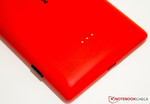
After the good result of the Lumia 520, we had expectations of the phone in this category. Unfortunately, it is immediately apparent that our expectations were either too high or that the performance of the mono speaker is just not very convincing. Even medium volume levels produce distortions and deliver an unpleasant result. Playback with a higher volume setting is even worse. You also get additional distortions if the smartphone is lying on a flat surface since the design of the device covers the speaker.
Power Management
Energy Consumption
Based on the identical hardware equipment and the similarly bright display, the energy consumption of our review unit should also be similar to the Lumia 620. But the 4.3-inch device is even more frugal during idle with values between 0.3 and 1.9 W. The smaller sibling consumed between 1.2 and 2.2 W. It is the same situation with the consumption under load (0.8 up to 2.2 W) for the Lumia 720. Even with maximum display brightness and maximum load on the SoC, our review unit needs less energy than the Lumia 620 with 2.8 up to 4.4 W while the 720 only consumes 3.1 up to 3.3 W.
| Off / Standby | |
| Idle | |
| Load |
|
Key:
min: | |
Battery Runtime
Compared to the Lumia 620, Nokia equipped the 520 with a 130 mAh larger battery and the jump to the Lumia 720 is even bigger. A 2,000 mAh (7.4 Wh) capacity ensure very good battery runtimes. Combined with the lower energy consumption, the battery runtimes should be significantly longer. We ran three different tests to support our assumptions. The battery keeps the device running for 3 hours and 33 minutes under load, the display brightness was set to maximum and all the wireless modules were activated. The direct opposite of this test is simulated with minimum display brightness and deactivated wireless modules; the battery ran dry after 21 hours and 40 minutes. The WLAN scenario is more realistic: The display brightness is set to Medium, which corresponds to about 226 cd/m², and web pages are constantly refreshed. The device turned off after 15 hours and 51 minutes and a full recharge of the battery took 3 hours and 20 minutes.
Verdict
At first glance, the only difference of the Lumia devices is the screen size. The SoC Qualcomm Snapdragon S4 MSM8227 with 1 GHz is often used for entry-level and mainstream devices. A closer look however reveals other differences that make the Lumia 720. The IPS display is unrivaled in its brightness levels and has high viewing angle stability. The battery was also improved by the Finish manufacturer; the 2,000 mAh battery is significantly more enduring than the smaller siblings. NFC and dual band WLAN are also integrated.
We can find a reason for the existence of the Lumia 720. The SoC delivers sufficient performance and the hardware is decent enough. One major drawback is the high retail price of 379 Euros. Some online shops are a bit cheaper selling the device at around 330 Euros (~$430) - but you can get more powerful devices for that kind of money, for example, the Google Nexus 4.




